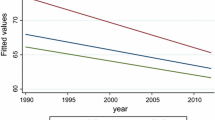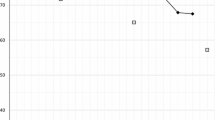Abstract
Research exploring participation in primaries by way of aggregate data faces the problem of finding an appropriate denominator on which to calculate turnout. Decisions need to be made on whether, and how, to divide either registered voters or the voting age population into partisan subsets. In order to cope with this problem, numerous methods have been devised to measure turnout. This paper explores the merits and compatibility of four of these measures, determining that the measure based on the “normal vote” has theoretical and empirical advantages over the others.
Similar content being viewed by others
References
Carr, Craig L., and Scott, Gary L., (1984). The logic of state primary classification schemes.American Politics Quarterly 12:465–476.
Finkel, Steven E., and Scarrow, Howard A. (1984). Party identification and party enrollment: the differences and the consequences. Paper presented at the annual meeting of the American Political Science Association, Washington D.C.
Jewell, Malcolm E. (1977). Voting turnout in state gubernatorial primaries.Western Political Quarterly 30:236–254.
Jewell, Malcolm E. (1984a). Northern state gubernatorial primary elections: explaining voting turnout.American Politics Quarterly 12:101–116.
Jewell, Malcolm E. (1984b).Parties and Primaries: Nominating State Governors. New York: Prager.
Kenney, Patrick J. (1983). Explaining turnout in gubernatorial primaries.American Politics Quarterly 11:315–326.
Kenney, Patrick J. (1986). Explaining primary turnout: the senatorial case.Legislative Studies Quarterly 11:65–73.
Kenney, Patrick J., and Rice, Tom W. (1985). Voter turnout in presidential primaries: a cross-sectional examination.Political Behavior 7:101–111.
Key, V. O., Jr. (1956).American State Politics: An Introduction. New York: Knopf.
Moran, Jack, and Fenster, Mark (1982). Voter turnout in presidential primaries: a diachronic analysis.American Politics Quarterly 10:453–476.
Morris, William D., and Davis, Otto A. (1975). The sport of kings: turnout in presidential preference primaries. Paper presented at the annual meeting of the American Political Science Association, San Francisco.
Norrander, Barbara, and Smith, Gregg W. (1985). Type of contest, candidate strategy, and turnout in presidential primaries.American Politics Quarterly 13:28–50.
Overacker, Louise (1926).The Presidential Primary. New York: Macmillan.
Ranney, Austin (1972). Turnout and representation in presidential primary elections.American Political Science Review 66:21–37.
Ranney, Austin (1977).Participation in American Presidential Nominations. Washington, D.C.: American Enterprise Institute.
Schier, Steven E. (1982). Turnout choice in presidential nominations: a case study.American Politics Quarterly 10:231–245.
Zeidenstein, Harvey (1970). Presidential primaries: reflection of “the people's choice”?Journal of Politics 32:856–874.
Author information
Authors and Affiliations
Rights and permissions
About this article
Cite this article
Norrander, B. Measuring primary turnout in aggregate analysis. Polit Behav 8, 356–373 (1986). https://doi.org/10.1007/BF00988437
Issue Date:
DOI: https://doi.org/10.1007/BF00988437




